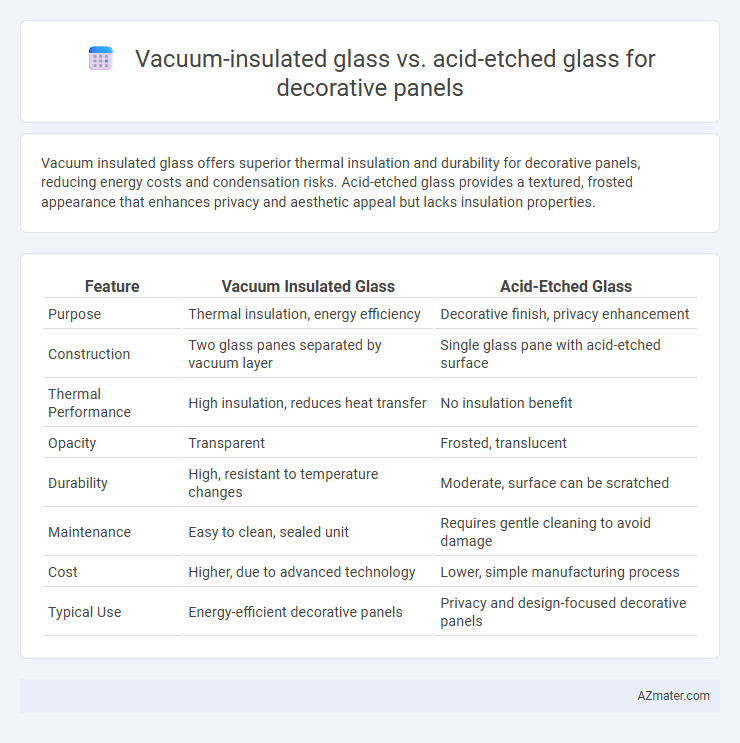Vacuum insulated glass offers superior thermal insulation and durability for decorative panels, reducing energy costs and condensation risks. Acid-etched glass provides a textured, frosted appearance that enhances privacy and aesthetic appeal but lacks insulation properties.
Table of Comparison
| Feature | Vacuum Insulated Glass | Acid-Etched Glass |
|---|---|---|
| Purpose | Thermal insulation, energy efficiency | Decorative finish, privacy enhancement |
| Construction | Two glass panes separated by vacuum layer | Single glass pane with acid-etched surface |
| Thermal Performance | High insulation, reduces heat transfer | No insulation benefit |
| Opacity | Transparent | Frosted, translucent |
| Durability | High, resistant to temperature changes | Moderate, surface can be scratched |
| Maintenance | Easy to clean, sealed unit | Requires gentle cleaning to avoid damage |
| Cost | Higher, due to advanced technology | Lower, simple manufacturing process |
| Typical Use | Energy-efficient decorative panels | Privacy and design-focused decorative panels |
Introduction to Decorative Glass Panels
Vacuum insulated glass offers superior thermal insulation and soundproofing for decorative panels, making it ideal for energy-efficient architectural designs. Acid-etched glass provides a unique frosted aesthetic with versatile patterns, enhancing privacy while allowing diffused light transmission. Choosing between these options depends on balancing functional performance with desired visual effects in decorative glass panels.
Understanding Vacuum Insulated Glass
Vacuum insulated glass (VIG) utilizes a vacuum layer between two glass panes, offering superior thermal insulation and minimizing heat transfer compared to acid-etched glass. This technology enhances energy efficiency in decorative panels while maintaining a sleek, transparent appearance unlike the opaque, textured finish of acid-etched glass. VIG's durability and clarity make it ideal for applications demanding both aesthetic appeal and thermal performance.
Overview of Acid-Etched Glass
Acid-etched glass offers a matte, frosted appearance achieved through the controlled application of acid, creating a smooth, uniform texture ideal for decorative panels. This glass type provides excellent light diffusion and privacy without compromising translucency, making it a popular choice for interior partitions and architectural features. Compared to vacuum insulated glass, acid-etched glass emphasizes aesthetic enhancement and surface texture rather than thermal insulation or energy efficiency.
Thermal Performance Comparison
Vacuum insulated glass offers superior thermal insulation with a U-value as low as 0.3 W/m2K, significantly reducing heat transfer compared to acid-etched glass, which typically has a U-value around 5.7 W/m2K. The vacuum layer in vacuum insulated glass minimizes conduction and convection, enhancing energy efficiency in decorative panels. Acid-etched glass provides aesthetic diffusion but lacks thermal performance benefits due to its single-pane construction without insulating properties.
Aesthetic Appeal and Customization Options
Vacuum insulated glass offers a sleek, modern aesthetic with high transparency and minimal distortion, enhancing the visual clarity of decorative panels. Acid-etched glass provides a unique, frosted texture that diffuses light softly, creating privacy while allowing for intricate, customizable patterns and designs. Both materials support diverse customization options, but acid-etched glass excels in artistic surface treatments, whereas vacuum insulated glass prioritizes clarity and thermal performance without compromising style.
Durability and Maintenance
Vacuum insulated glass offers superior durability for decorative panels due to its robust construction that resists thermal stress and moisture infiltration, ensuring long-lasting performance with minimal maintenance. Acid-etched glass, while providing a unique textured aesthetic, is more prone to surface wear and may require regular cleaning to maintain its appearance, making it less durable in high-traffic or harsh environments. Choosing vacuum insulated glass enhances structural integrity and reduces upkeep costs, ideal for applications demanding longevity and minimal maintenance efforts.
Energy Efficiency in Building Design
Vacuum insulated glass (VIG) provides superior thermal insulation with a near-vacuum space reducing heat transfer, achieving U-values as low as 0.5 W/m2K, which significantly enhances energy efficiency in building design. Acid-etched glass, while primarily used for aesthetic purposes and privacy, has minimal impact on thermal performance and does not contribute to energy savings. Integrating vacuum insulated glass panels in decorative elements optimizes natural light usage while maintaining thermal comfort, reducing heating and cooling loads effectively.
Cost Analysis: Vacuum Insulated vs. Acid-Etched
Vacuum insulated glass typically incurs higher manufacturing and installation costs due to advanced technology and thermal performance benefits, making it a premium choice for decorative panels. Acid-etched glass, while more affordable, offers lower insulation properties but excels in aesthetic versatility with various patterns and textures. Cost analysis should weigh upfront expenses against long-term energy savings provided by vacuum insulated glass in climate-controlled environments.
Best Applications for Each Glass Type
Vacuum insulated glass excels in decorative panels requiring thermal insulation and energy efficiency, making it ideal for exterior facades and climate-controlled environments. Acid-etched glass offers superior privacy and diffuse light transmission, perfect for interior partitions, office dividers, and decorative wall features. Combining both types can optimize functionality by balancing aesthetics, insulation, and privacy in advanced architectural designs.
Choosing the Ideal Decorative Panel Solution
Vacuum insulated glass offers superior thermal insulation and energy efficiency for decorative panels, making it ideal for environments requiring temperature control and durability. Acid-etched glass provides a distinctive aesthetic with its textured, matte finish that enhances privacy while allowing light diffusion, perfect for artistic or decorative needs. Choosing the ideal decorative panel depends on balancing energy performance with design preferences and the specific functionality desired in residential or commercial spaces.

Infographic: Vacuum insulated glass vs Acid-etched glass for Decorative panel
 azmater.com
azmater.com